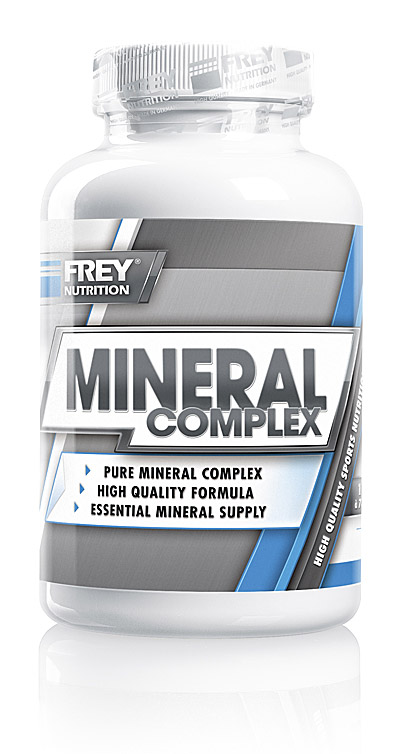MINERALS | NOT ONLY IMPORTANT FOR ATHLETES
Minerals are inorganic components of food that the body cannot produce itself. Minerals are essential (vital) components of all living cells and are involved in metabolism. Humans need minerals for numerous functions, such as building body substances (bones, muscles) and maintaining enzyme activities.
The most important minerals include magnesium, calcium, potassium, sodium, potassium, phosphorus and chloride. It is important to ensure adequate intake, especially during physical activity and during periods of intense physical exertion. Mineral deficiencies occur when intake is too low or excretion is increased. A varied, mixed diet usually covers the minimum mineral requirements of non-athletes. Athletes have an increased need due to the mineral consumption through sweat and should cover this with mineral-rich foods or nutritional supplements.
Sodium is the only mineral that is virtually non-deficient, as daily intake (on average 10 to 15 g) far exceeds daily requirements. This excess of table salt, which is mostly caused by eating ready meals and/or foods containing salt, can lead to high blood pressure, cardiovascular stress and water retention. On the other hand, it is just as wrong to eliminate all sodium from the diet, as sodium has important functions in the body and is excreted in increased amounts through sweat, which is why sporting activities can quickly lead to deficiency symptoms in the form of cramps or dizziness. For athletes, an adequate sodium intake is therefore particularly important.
Sodium is mainly found in the extracellular space (i.e. outside the cells, i.e. under the skin), whereas potassium is mostly found in the intracellular level. Sodium and potassium are opponents and should always be consumed in equal concentrations with daily food. Targeted manipulation of the water balance only makes sense shortly before a competition. By completely eliminating sodium a few days before a competition and simultaneously increasing potassium intake, the body stores more intracellular water. The muscles become plump and full, and the skin becomes thin and defined due to the removal of extracellular fluid. During normal training phases, however, this measure is unnecessary and can lead to a significant drop in performance due to the osmotic imbalance.
OCCURRENCE | IMPORTANCE | NEED
| minerals | Happen | Meaning | Requirement* |
| magnesium | milk Meat Fruit |
- Enzyme activator for Carbohydrates and proteins - neuromuscular excitability |
375mg |
| Calcium | milk and milkproducts Vegetables nuts |
- Bone building - Enzyme activator - Muscle contraction - Blood clotting |
800mg |
| potassium | Bananas tomatoes Dried fruits |
- osmotic pressure (intracellular) - neuromuscular excitability - Glycogen formation - Protein synthesis |
2000mg |
| sodium | Table salt salted foods Ready meals |
- osmotic pressure (extracellular) - neuromuscular excitability |
550mg |
| phosphorus | milk Meat nuts |
- Bone building - Component of cell structures - Co-factor for enzymes |
700mg |
| chloride | see sodium | - see sodium - Gastric hydrochloric acid formation |
800mg |
* Recommended intake according to RDA (= Recommended Dietary Allowances )
Annotation: The recommended intake according to RDA is aimed at non-athletes and does not take additional sporting activities into account. Depending on the intensity of the sport and the phase (diet or build-up phase), athletes may have a significantly increased need.
MAGNESIUM
Magnesium is a component of bones and teeth. It supports the transmission of nerve impulses and is important for muscle contraction. It is present in almost all cells in the body. Magnesium plays a major role in the daily supply of minerals, as it is involved in numerous processes in the body and is especially important for the regulated and sufficient release of growth hormones.
ORGANIC MAGNESIUM AS CITRATE IS SIGNIFICANTLY MORE BIOAVAILABLE THAN INORGANIC FORMS SUCH AS OXIDE OR CARBONATE .
While daily amounts of around 300 to 400 mg are sufficient for non-athletes, these are far too low for athletes and can lead to severe cramps. Anyone who has ever had a nighttime calf cramp knows how painful these deficiency symptoms can be. 95% of nighttime calf cramps are caused by a magnesium deficiency. Due to the strain of training, the minimum requirement for athletes is around 500 to 700 mg per day and can rise to 2000 mg or more per day.
The more intense a training session, the more magnesium is used and the need is accordingly higher. However, the need for magnesium is not only related to the training sessions and the intensity, but is also significantly influenced by muscle mass. The more muscle mass there is, the more magnesium the body needs. Heavy athletes in particular should pay attention to this fact and adjust their magnesium intake accordingly.
MAGNESIUM is contained in most foods, but especially in whole grain products, fruit and milk. There are significant differences in the quality and absorption behavior of magnesium in the form of dietary supplements. Depending on the magnesium salt used, the bioavailability can vary enormously. Inorganic magnesium, especially the oxide, is the worst absorbed, followed by sulfate and carbonate. Organic forms of magnesium, such as magnesium citrate and magnesium aspartate, are particularly well absorbed. Since these forms are most similar to the body, they are absorbed even better. This fact should be considered the next time you buy magnesium, especially since almost all magnesium preparations from health food stores or pharmacies contain the poor oxide form.
Unfortunately, the pharmacist's recommendation is not very reliable, as the motive of profit often replaces the lack of knowledge by always offering Mg oxide. Since the oxide form is the cheapest to produce, the profit is correspondingly greater. Therefore, you should politely decline the "well-intentioned" offer and insist on a high-quality magnesium preparation bound to citrate or aspartate.
You often hear the claim that magnesium should not be taken with calcium. This is true if you only take magnesium and calcium without a meal. In this case, there does indeed seem to be a mutual impairment of absorption. If, however, magnesium and calcium are taken with a meal, both minerals are optimally absorbed. Since mineral supplements are generally taken with meals, such fears are irrelevant anyway.
MAGNESIUM-RICH FOODS (PER 100 G)
- Flaxseed = 350 mg
- Almonds = 220 mg
- Rice = 150 mg
- Corn = 120 mg
- Meat = 50 mg
CALCIUM
Calcium is important for the development of bones and teeth, the transmission of nerve impulses, muscle contraction and blood clotting. Calcium is present in the body in greater quantities than any other mineral. Milk and dairy products are particularly good sources of calcium. Since just one liter of milk contains around 1200 mg of calcium, it is not a problem to meet your daily needs by consuming milk and dairy products.
During training sessions, calcium ensures optimal contraction of the trained muscles. Adequate intake is important from this point of view alone, which is why it can make sense to supplement calcium specifically shortly before training.
Athletes who completely avoid milk and dairy products or those who suffer from lactose intolerance should also cover their calcium needs with food. There are not as many major differences in the bioavailability of calcium between the various forms as there are with magnesium. Inorganic compounds are absorbed just as well as organic ones.
A tip: 3 to 4 ampoules of Frubiase Calcium (available in all pharmacies) 30 minutes before the next heavy workout can do wonders for your strength levels! The improved muscle contraction makes weight gains of up to 10% possible.
CALCIUM-RICH FOODS (PER 100 G)
- Emmental = 1050 mg
- Sesame = 780 mg
- Milk = 120 mg
- Vegetables = 120 mg
- Quark = 80 mg
POTASSIUM
Potassium keeps the water and electrolyte balance in balance, ensures a regular heartbeat, regulates blood pressure and is important for the transmission of nerve impulses. Together with sodium and chloride, it controls the water and electrolyte balance. However, unlike sodium, potassium is found almost exclusively within the cell.
It takes on functions in energy metabolism and supports transport processes, such as the transport of food components into the cells. This property makes potassium particularly important for athletes who train intensively, as potassium, together with insulin, promotes the transport of carbohydrates and proteins directly after training.
Furthermore, potassium is important for glycogen supercompensation (see also: THE INSULIN THEORY ) is important shortly before a competition and is used specifically in the last few days before a competition. Since glycogen can only be stored in the muscles if there is potassium and water, a sufficient intake of potassium is crucial for performance. Plant-based foods contain a particularly high amount of potassium. This also includes fruit such as bananas and fruit in dried form.
POTASSIUM-RICH FOODS (PER 100 G)
- Apricots (dried) = 1700 mg
- Peanuts = 700 mg
- Plums (dried) = 700 mg
- Bananas = 400 mg
- Beef = 300 mg
SODIUM
Sodium determines the volume and pressure of body fluids outside the cells, such as blood, and together with potassium regulates the body's water balance. Sodium plays a crucial role in the transmission of nerve impulses and is important for acid-base balance.
A sodium deficiency, which can occur, for example, through excessive sweating or prolonged diarrhea, leads to dehydration of the body and to disorders of kidney and muscle function. As with a magnesium deficiency, calf cramps are often the first sign of a sodium deficiency. In general, high salt consumption leads to increased excretion of sodium via the kidneys, which also flushes out calcium.
Too much salt can increase or even cause high blood pressure in people who are sensitive to sodium. It can also lead to edema (water retention).
However, it is not only the excess of sodium that leads to side effects, but also low sodium levels, especially in conjunction with excessive endurance exercise. Sweating and the associated loss of sodium can lead to a significant drop in performance, which is why a sodium-free diet, as is often practiced in bodybuilding circles, is not recommended.
SODIUM NOT ONLY ENHANCES GLYCOGEN TRANSPORT, BUT ALSO INCREASES CREATINE INTO MUSCLE CELLS.
When taken after training, sodium increases fluid absorption in the intestines and actively supports glycogen storage in the muscles. Faster absorption of nutrients, which is desirable and important after training, is positively supported when combined with sodium. Scientific studies have also shown that creatine is also absorbed in a sodium-dependent manner and can be absorbed more quickly and efficiently in the presence of a small amount of sodium. A pinch of salt in the post-workout shake immediately after training is a good idea due to the positive effects mentioned. If this makes the shake too salty and inedible for you, you can also use so-called "Swedish tablets". 0.75 g of sodium is enough for optimal glycogen, nutrient and creatine absorption. It should be noted that salt or table salt is not the same as sodium. In order to absorb 750 mg of sodium through table salt, a multiplier of 2.5 must be used, which corresponds to an amount of 1875 mg of table salt (1 g of sodium = 2.5 g of table salt).
PHOSPHORUS
Phosphorus ensures healthy bones and teeth. It is needed for the utilization of nutrients and to release energy in the cells. In addition, phosphorus is involved in most processes in the body, especially in the production and storage of energy, as well as in the regulation of kidney function and the heart and acid-base balance. In the blood, phosphorus acts as a buffer to maintain the pH value. Foods that are particularly rich in protein, such as meat and fish, but also bread and cheese, contain phosphorus. A phosphorus deficiency is rare and does not occur with a varied, meat-rich diet.
CHLORIDE
Chloride regulates the water and electrolyte balance and is important for the formation of stomach acid. As with sodium, heavy sweating or persistent vomiting can lead to a chloride deficiency, which can lead to an impairment of the acid-base balance with muscle cramps and cardiac dysfunction. Excess chloride is excreted via the kidneys. Chloride is mainly absorbed in the form of table salt (NaCl) in combination with sodium. If sodium intake is sufficient, a deficiency is not possible.














